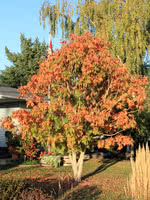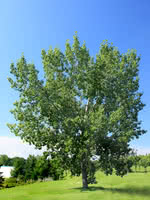Mon-Fri 9am - 5pm Mountain time
Ohio Buckeye vs Balsam Poplar
Aesculus glabra
Populus balsamifera
Ohio Buckeye is a medium sized deciduous tree. If you are looking for a shade tree, Ohio Buckeye's dense canopy of unique leaves can provide it.
Named after its fruit, an inedible nut enclosed in a prickly husk, Ohio Buckeye also features green-yellow flowers and long, broad leaves that turn brilliant red in the fall.
Slow growing, but an extremely attractive tree. Find out what experienced horticulturalists already know: this tree is a gem.
A top CO2 absorbing species. Experts think this tree may help climate change more than others.
Balsam Poplar is a hardy, fast-growing deciduous tree that is Native to Canada east of the Rockies.
We grow them in two variations. Sometimes they are a male clones, so they don't produce fluff. Other times, we grow them from seed, which will result in fluff. The detailed descriptions (see below) will tell you which is which.
Ohio Buckeye Quick Facts
Balsam Poplar Quick Facts
Toxicity: nuts are toxic to humans and cattle
In row spacing: 2.4 - 3 m (8 - 10 ft)

